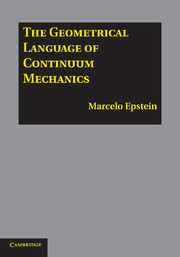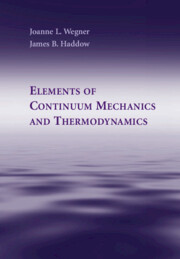The Geometrical Language of Continuum Mechanics
Epstein presents the fundamental concepts of modern differential geometry within the framework of continuum mechanics. Divided into three parts of roughly equal length, the book opens with a motivational chapter to impress upon the reader that differential geometry is indeed the natural language of continuum mechanics or, better still, that the latter is a prime example of the application and materialisation of the former. In the second part, the fundamental notions of differential geometry are presented with rigor using a writing style that is as informal as possible. Differentiable manifolds, tangent bundles, exterior derivatives, Lie derivatives, and Lie groups are illustrated in terms of their mechanical interpretations. The third part includes the theory of fiber bundles, G-structures, and groupoids, which are applicable to bodies with internal structure and to the description of material inhomogeneity. The abstract notions of differential geometry are thus illuminated by practical and intuitively meaningful engineering applications.
- Motivational chapter demonstrates to the reader the advantages of a geometrical approach to mechanics
- Emphasises the application of the mathematical concepts to the mechanics of deformable media by means of conceptual examples
- Each chapter includes exercises at various levels of difficulty, allowing readers to test their understanding of concepts
Reviews & endorsements
The Geometrical Language of Continuum Mechanics brings a fresh quality to this subject by blending differential topology with tensor analysis....the author is commended for making the materials accessible to the reader by including in the first chapter excellent introductory background topics, which are essential for unraveling interconnected abstractions in subsequent chapters." R.N Laoulache, University of Massachusetts Dartmouth
"...the author is commended for making the materials accessible to the reader by including in the first chapter excellent introductory background topics, which are essential for unraveling interconnected abstractions in subsequent chapters. ...Recommended." CHOICE
Product details
January 2014Paperback
9781107617032
326 pages
254 × 178 × 17 mm
0.57kg
39 b/w illus. 142 exercises
Available
Table of Contents
- Part I. Motivation and Background:
- 1. The case for differential geometry
- 2. Vector and affine spaces
- 3. Tensor algebras and multivectors
- Part II. Differential Geometry:
- 4. Differentiable manifolds
- 5. Lie derivatives, lie groups, lie algebras
- 6. Integration and fluxes
- Part III. Further Topics:
- 7. Fibre bundles
- 8. Inhomogeneity theory
- 9. Connection, curvature, torsion
- Appendix A. A primer in continuum mechanics.






